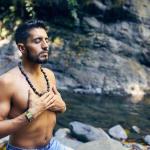 Someone, maybe you, has been feeling angry about politics. Another, maybe you, has been fearful about pandemics or food supply. Many are stressed, and far worse, due to war, violence, and displacement. Many more are having anxiety about the potential of it spreading. Someone, maybe you, are having a health crisis. Or, maybe the little aches and pains are increasing and creating a nagging reminder of your mortality. Financial worries, job issues, family or friends, relationships, self esteem – there are untold sources of pain, suffering, worry, fear, anger, stress, sickness, disease, failure, and more. It all seems so complex, so unique, so isolating, and so solitary.
Someone, maybe you, has been feeling angry about politics. Another, maybe you, has been fearful about pandemics or food supply. Many are stressed, and far worse, due to war, violence, and displacement. Many more are having anxiety about the potential of it spreading. Someone, maybe you, are having a health crisis. Or, maybe the little aches and pains are increasing and creating a nagging reminder of your mortality. Financial worries, job issues, family or friends, relationships, self esteem – there are untold sources of pain, suffering, worry, fear, anger, stress, sickness, disease, failure, and more. It all seems so complex, so unique, so isolating, and so solitary.
This is why we all crave simplicity; one elegant solution that solves all our problems and gives us a reliable, clear guide out. Those who promise such things are generally trying to sell you something. The philosophies that have the most ardent communities and defenders will be those that boil everything down to one principle or value. But this is also what deludes or drives adherents to radicalism – where pain is merely disguised with hate or being abused.
While there is no such miracle pill, there is good news. There are pathways to joy and peace. But this approach is not a ‘prosperity doctrine’ that promises you success in life, love, fortune, or fame. Nor does this approach require you to brainwash yourself into believing outlandish, unfounded, or irrational absurdities. And lastly, it is not anything that requires giving your money to this or any other group or product.
Part of this approach is understanding the common thread to suffering. True, it is complex, diverse, and everyone has their own experience. But all of the examples listed above, and more, have something in common. They all spring from dissatisfaction with the precarious and temporary nature of conditions in life. Whether regret, sorrow, or anger about a past or present loss – or anxiety, worry, or fear about a future one.
There is a ‘program’ of sorts we are always running in our minds. It has to do with looking at conditions, comparing to goals, and working out pathways to bring or keep the conditions consistent with those goals. Every organism engages in this activity as a requisite for its continued survival and prosperity. It is perhaps the most deeply embedded activity of our nervous system.
Contrary to what you may have heard, traditions that focus on peace, equanimity, acceptance, etc. are not about shutting that program down. That would be lunacy, and make life impossible. Action in the world is essential, and also a moral imperative.
Instead we begin by simply seeing the program; understanding and recognizing its operation within us. Then we can begin to uncover the sources of our fears, anger, and pain. We can examine whether the program is really serving us or not, and what changes may be needed. This ‘seeing’ the program begins with simple learning, such as reading views like this article, and then on to more advanced materials.
But there is a deeper kind of seeing that is not merely intellectual and no amount of reading can achieve. It is more like an intuitive consciousness of our own minds. This kind of insight requires engaging in regular practices. Yes, mindfulness meditation is one, but there are many ways of clearing one’s mind, stilling it, exercising our ability to focus, and building habits of self monitoring. This kind of seeing allows us to stay aware of the program running in the moment it would normally overtake our freedom of will.
Once we have built habits of seeing, this allows us to more closely examine the workings of the program. That is, the stories we tell ourselves. We can pause and unfold that process. And when we do, we will find that unhealthy patterns always arise from errors and false judgments.
This often includes a kind of ‘war with Nature’. By that I mean that we forget the impermanent nature of reality. We take the current situation for granted. We hide our eyes from that which is uncomfortable. As we examine these assumptions and mental habits, we can begin to ‘sober up’ and face reality as it is.
But that is not enough. Simply accepting the impermanence and uncertainty in life can and will easily lead to a kind of coldness, or nihilism – and that is simply another form of suffering. And this reveals an even deeper false judgment: that something is bad, or ugly, or meaningless simply because it is in opposition to our programming.
That program we worked to see operating in ourselves runs on a core set of drives, and those drives evolved to keep us alive. But that creates a solitary bias in how we evaluate all things. What we can do is begin to see beyond that bias – beyond the filter that our ego places upon the world. When we do, then we can begin to appreciate the intricate beauty of the ever-changing cosmos; the rise and fall of its infinite forms. We move from a self-centered grasping, to a larger perspective of simply being.
And as we glimpse this state, we can begin to be at peace with impermanence. We can enjoy the people and conditions in the present without turning away from their inevitable finitude. Instead of causing discomfort and anxiety, that awareness of the transience of all things becomes a source of greater appreciation.
Of course, we have to be careful not to fake this kind of state. Suppressing and denying our worries, fears, and angers is unhealthy. But if we confront those honestly, we can meanwhile be working on the foundations that can build this kind of consciousness in the long run. That means a practice of building greater mindfulness, awareness of our internal thoughts and impulses, control of our attention and focus, and an examination of the workings of our ‘program’. And, as always, trying to be patient, tolerant of our human imperfections, and self-compassionate.
This is a very broad and general picture of a path that is referenced in many different contemplative practices. Although they use a wide variety of their own definitions, practices, and terms; many commonalities in them include the notions described here. I hope this may be useful and inspire those who are interested to continue their exploration.
Subscribe to The Spiritual Naturalist Society
Learn about Membership in the Spiritual Naturalist Society
__________
The Spiritual Naturalist Society works to spread awareness of spiritual naturalism as a way of life, develop its thought and practice, and help bring together like-minded practitioners in fellowship.
SNS strives to include diverse voices within the spectrum of naturalistic spirituality. Authors will vary in their opinions, terms, and outlook. The views of no single author therefore necessarily reflect those of all Spiritual Naturalists or of SNS.
















